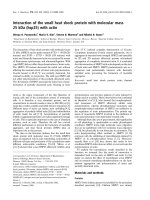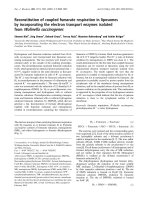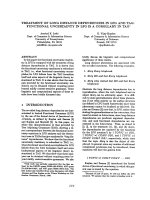Báo cáo khoa học: "Incidence of synchronous appendiceal neoplasm in patients with colorectal cancer and its clinical significance" docx
Bạn đang xem bản rút gọn của tài liệu. Xem và tải ngay bản đầy đủ của tài liệu tại đây (174.78 KB, 4 trang )
BioMed Central
Page 1 of 4
(page number not for citation purposes)
World Journal of Surgical Oncology
Open Access
Research
Incidence of synchronous appendiceal neoplasm in patients with
colorectal cancer and its clinical significance
Varut Lohsiriwat*, Akkrarash Vongjirad and Darin Lohsiriwat
Address: Department of Surgery, Faculty of Medicine Siriraj Hospital, Mahidol University, Bangkok 10700, Thailand
Email: Varut Lohsiriwat* - ; Akkrarash Vongjirad - ; Darin Lohsiriwat -
* Corresponding author
Abstract
Background: The aims of this study were to evaluate the incidence of synchronous appendiceal
neoplasm in patients with colorectal cancer, and to determine its clinical significance.
Methods: Pathological reports and medical records were reviewed of patients with colorectal
adenocarcinoma who underwent oncological resection of the tumor together with appendectomy
at the Faculty of Medicine Siriraj Hospital, Mahidol University, Thailand between September 2000
and April 2008.
Results: This study included 293 patients with an average age of 62 years (range 19–95) and 51
percent were male. Of the patients studied, 228 (78 percent) had right hemicolectomy, whereas
the others (22 percent) had surgery for left-sided colon cancer or rectal cancer. One patient (0.3
percent) had epithelial appendiceal neoplasm (mucinous cystadenoma) and 3 patients (1.0 percent)
had metastatic colorectal cancer in the mesoappendix. However, the presence of synchronous
appendiceal tumors and/or metastasis did not alter postoperative management, as these patients
had received adjuvant therapy and were scheduled for surveillance program because of nodal
involvement.
Conclusion: The incidence of synchronous primary appendiceal neoplasm and secondary
(metastatic) appendiceal neoplasm in colorectal cancer patients was 0.3 and 1.0 percent,
respectively. However, these findings did not change the postoperative clinical management.
Background
Synchronous colorectal cancer (CRC) has been reported
in 0.6–1.4 percent of patients and metachronous CRC in
1–8 percent of patients [1]. Any neoplastic change of the
colon and rectum could possibly affect the appendix
because the appendix is derived embryologically from the
large intestine and has a similar mucosal pattern to the
colon and rectum. The histological features of appendi-
ceal adenocarcinoma are also identical to those of color-
ectal adenocarcinoma [2]. Moreover, it has been reported
that almost a quarter of patients with appendiceal cancer
are found to have synchronous or metachronous neo-
plasms elsewhere in the large intestine [2,3].
Although there have been increasing advances in both
endoscopy and radiology, the appendiceal mucosa
remains inaccessible and the accuracy of preoperative
diagnosis of appendiceal neoplasm is still poor. During
an operation, a correct diagnosis is made in less than half
of the cases [4]. Several case reports of synchronous
Published: 2 June 2009
World Journal of Surgical Oncology 2009, 7:51 doi:10.1186/1477-7819-7-51
Received: 8 March 2009
Accepted: 2 June 2009
This article is available from: />© 2009 Lohsiriwat et al; licensee BioMed Central Ltd.
This is an Open Access article distributed under the terms of the Creative Commons Attribution License ( />),
which permits unrestricted use, distribution, and reproduction in any medium, provided the original work is properly cited.
World Journal of Surgical Oncology 2009, 7:51 />Page 2 of 4
(page number not for citation purposes)
appendiceal tumors in CRC patients have been published
in the literature [5-9], but only one study has explored its
incidence which is about 4 percent of CRC patients having
synchronous appendiceal neoplasm [7]. Given the diffi-
culty in diagnosis of appendiceal tumors and the certain
risk of synchronous and metachronous neoplasm of the
appendix, the question of whether an incidental appen-
dectomy should be performed in CRC patients has been
raised [5,7].
In attempt to address this question, it is first essential to
know the incidence and the biological significance of syn-
chronous appendiceal tumors in CRC patients. The aims
of this study were to evaluate the incidence of synchro-
nous appendiceal neoplasm in patients with resectable
CRC in a university hospital, and to determine the clinical
significance of these findings.
Methods
Pathological reports and medical records were retrospec-
tively reviewed of patients with colorectal adenocarci-
noma who underwent oncological resection of the tumor
together with appendectomy at the Department of Sur-
gery, Faculty of Medicine Siriraj Hospital, Mahidol Uni-
versity, Bangkok, Thailand between September 2000 and
April 2008. Patients were excluded if they had familial
adenomatous polyposis syndrome or had had a previous
appendectomy, or if there had been direct invasion of
CRC to the appendix. Patients receiving neoadjuvant ther-
apy were also excluded. Notably, there were about 100–
120 operations for CRC per annum in our unit, and one-
third of them were for right-sided colon cancer.
The appendix is normally a part of the specimen removed
in patients with right hemicolectomy. All the appendices
removed along with the right colon specimen were sys-
tematically analyzed. Incidental appendectomy had also
been performed in patients who had undergone left hemi-
colectomy or rectal resection at the discretion of the sur-
geon. We tended to perform incidental appendectomy if
the patient was younger than 45 years, or there was a fec-
alith in the appendix. Histopathological study of the
appendix included gross and microscopic examination.
Specimens were sectioned at the tip, body, and base of the
appendix as well as other suspicious lesions. All speci-
mens were examined by a consultant or senior patholo-
gist.
The site of the primary tumor, type of operation, and
pathological staging of CRC were noted. Macroscopic and
microscopic features of the appendix were also recorded.
The presence of synchronous appendiceal tumors and/or
metastasis was correlated with follow-up data to demon-
strate the clinical significance of these findings. The study
was approved by the Institutional Ethics Committee.
Results
Two hundred and ninety-three patients were included in
this study. The patients studied had an average age of 62
years (range 19–95) and 51 percent were male. Of the
patients studied, 228 (78 percent) had a right hemicolec-
tomy, 45 (15 percent) had a left hemicolectomy, and 20
(7 percent) had surgery for rectal cancer. One patient (0.3
percent) had epithelial appendiceal neoplasm (mucinous
cystadenoma), and 3 patients (1.0 percent) had metastatic
colorectal cancer in the mesoappendix (Table 1). All met-
astatic lesions were mucinous adenocarcinoma. Clusters
of metastatic cancerous cells were 1–5 mm in diameter;
primarily located in the subserosal area. All appendices
with neoplasms did not appear abnormal in the preoper-
ative imaging and during the intraoperative examination.
However, the case of metastases in the mesoappendix
from a descending colon cancer was associated to other
peritoneal implants.
There was no specific morbidity that could be attributed
to incidental appendectomy in the present study. The
presence of synchronous appendiceal tumors and/or
metastasis did not alter postoperative management, as
these patients had received adjuvant therapy and were
scheduled for surveillance program because of nodal
involvement.
Discussion
The question of whether an incidental appendectomy
should be performed in CRC patients has been raised due
to the difficulty in diagnosis of appendiceal tumors and
the certain risk of synchronous and metachronous neo-
plasm of the appendix [5,7]. Little is known about the
incidence of appendiceal neoplasm in CRC patients. To
Table 1: Patients' characteristics, details of primary colorectal cancer, and pathological results of synchronous appendiceal neoplasm
Age (years)/Gender Primary tumor Type of surgery Staging of primary tumor Appendix abnormality
59 M cecum RH T3N2 Metastatic adenocarcinoma in the mesoappendix
62 F ascending colon RH T3N2 metastatic adenocarcinoma in the mesoappendix
48 M descending colon LH T3N1 Metastatic adenocarcinoma in the mesoappendix
64 F rectum APR T3N2 mucinous cystadenoma
Abbreviation: RH (right hemicolectomy), LH (left hemicolectomy), APR (abdominoperineal resection)
World Journal of Surgical Oncology 2009, 7:51 />Page 3 of 4
(page number not for citation purposes)
the best of our knowledge, there was only one study deter-
mining such an incidence [7]. Khan and Moran retrospec-
tively reviewed 169 CRC patients who underwent CRC
surgery and removal of the appendix in Basingstoke,
United Kingdom. They reported 4.1 percent synchronous
primary appendiceal neoplasm in these patients, and
mucinous cystadenoma was the most common neoplasm
found [7]. Furthermore, these authors suggested perform-
ing incidental appendectomy in all CRC patients. Mean-
while, Albright et al determined the cost-effectiveness of
interval appendectomy in patients who undergo curative
resection for CRC and found that the benefit in cost was
only realized for patients younger than 45 years of age [5].
Synchronous CRC and appendiceal tumors have been
observed in high-risk patients such as those with long-
standing ulcerative colitis [10]. Moreover, patients with
rectal cancer had a slightly higher rate of synchronous
appendiceal tumors than those with right-sided colon
cancer [7]. However, absent from the literature are such
studies in Asian population, in which the incidence of
synchronous appendiceal neoplasms in CRC patients
could be different.
The present study in Thailand demonstrates that the inci-
dence of synchronous primary appendiceal neoplasm and
secondary (metastatic) appendiceal neoplasm in patients
with resectable CRC is 0.3 and 1.0 percent, respectively.
One possible explanation for the low incidence of syn-
chronous primary neoplasm of the appendix in CRC
patients in the present study could be that tumorigenesis
of the appendix and other parts of the large intestine are
not the same. Appendiceal mucosa is not directly exposed
to potential carcinogens in fecal material as the colorectal
mucosa is. Epidemiological study revealed that appendi-
ceal tumors account for 0.4–1 percent of alimentary tract
cancers and are found in 0.7–1.7 percent of appendec-
tomy specimens [11], whilst CRC is the most common
gastrointestinal malignancy [12]. Also, the peak incidence
of appendiceal neoplasm is in patients in their early for-
ties, 20-year younger than that of CRC [13]. It is possible
that the incidence of appendiceal tumors in Asian popu-
lation is different from that of Western population [14],
and thus the incidence of synchronous appendieal neo-
plasms in CRC patients could vary among various ethnic
and geographic backgrounds. Lastly, in view of the exam-
ination of the specimens, different protocols of tissue sec-
tion and methods of histopathological examination may
lead to differences in the incidence percentages.
The unexpected finding in the present study was that one
percent of CRC patients had metastatic lesions in the mes-
oappendix. This finding was fairly consistent with a previ-
ous study by Albright and his colleagues [5]. They
reported 2 cases of metastatic implants to the appendix
from routine interval appendectomy in 210 patients with
intraabdominal malignancy; accounting for 0.95%. One
case was secondary to a sigmoid cancer with limited peri-
toneal carcinomatosis while the other was secondary to an
ovarian adenocarcinoma. As the mesoappendix encloses
the appendiceal artery and vein, together with lymphatic
vessels and lymph node, metastasis to the mesoappendix
could occur via the lymphatic, hematogenous or transcoe-
lomic route. With regard to the transcoelomic route, CRC
may spread throughout the peritoneum either via the sub-
peritoneal lymphatic drainage or by viable cells being
shed from the serosal surface of a tumor [15]. This is sup-
ported by the observations that 14.6 percent of CRC had
positive cytology for cancer cells on the peritoneal or per-
irectal surface of the bowel, particularly in those with
extensive lymphatic involvement, poorly differentiated
tumors, or liver metastases [16]. Metastasis to the appen-
dix has been reported in both gastrointestinal and non-
gastrointestinal malignancies such as gastric [17], pancre-
atic [18], ovarian [5,19], cervical [20], nasopharyngeal
[21], breast [22], and lung [23].
A limitation of this single-center study is a relatively small
sample size, particularly those with left-sided colon cancer
and rectal cancer. Considering this reason, a larger
number of incidental appendectomy in patients with left-
sided colon cancer and rectal cancer are warranted to ver-
ify our findings. Besides, this review has some limitations
which are mainly inherent to a retrospective study and to
different clinical judgments of surgeons. There could be a
selection bias to perform incidental appendectomy as we
did not have specific criteria for performing appendec-
tomy in CRC patient at our institute. It is possible that the
appendix was more likely to be removed because of its
abnormal appearance. In order to determine the true inci-
dence of synchronous appendiceal neoplasms, a cohort or
prospective study of patients where the appendix is always
removed (either by necessity in a right hemicolectomy
specimen; or as a protocol where the appendix is always
removed in CRC patients) is required.
Conclusion
Based on this study, the incidence of synchronous pri-
mary appendiceal neoplasm and secondary (metastatic)
appendiceal neoplasm in CRC patients was 0.3 and 1.0
percent, respectively. These findings did not change the
postoperative clinical management.
Abbreviations
APR: abdominoperineal resection; CRC: colorectal cancer;
LH: left hemicolectomy; RH: right hemicolectomy.
Competing interests
The authors declare that they have no competing interests.
Publish with BioMed Central and every
scientist can read your work free of charge
"BioMed Central will be the most significant development for
disseminating the results of biomedical research in our lifetime."
Sir Paul Nurse, Cancer Research UK
Your research papers will be:
available free of charge to the entire biomedical community
peer reviewed and published immediately upon acceptance
cited in PubMed and archived on PubMed Central
yours — you keep the copyright
Submit your manuscript here:
/>BioMedcentral
World Journal of Surgical Oncology 2009, 7:51 />Page 4 of 4
(page number not for citation purposes)
Authors' contributions
VL was the principal investigator who participated in
research design, analyzed the data, and prepared the man-
uscript. AV contributed to acquisition and analysis of
data. DL conceived of the study, participated in its design
and coordination, and helped to draft the manuscript. All
authors read and approved the final manuscript.
References
1. Benedetti M, Tinozzi FP, Dini S, Albertario S, Rossi G, Bianchi C,
Tinozzi S: Synchronous and metachronous tumours of colon
cancer. A review of 5 years of experience (1999–2004). Ann
Ital Chir 2006, 77:233-239.
2. Wolff M, Ahmed N: Epithelial neoplasms of the vermiform
appendix (exclusive of carcinoid). II. Cystadenomas, papil-
lary adenomas, and adenomatous polyps of the appendix.
Cancer 1976, 37:2511-2522.
3. Iwuagwu OC, Jameel JK, Drew PJ, Hartley JE, Monson JR: Primary
carcinoma of the appendix – Hull series. Dig Surg 2005,
22:163-167.
4. Nitecki SS, Wolff BG, Schlinkert R, Sarr MG: The natural history
of surgically treated primary adenocarcinoma of the appen-
dix. Ann Surg 1994, 219:51-57.
5. Albright JB, Fakhre GP, Nields WW, Metzger PP: Incidental appen-
dectomy: 18-year pathologic survey and cost effectiveness in
the nonmanaged-care setting. J Am Coll Surg 2007, 205:298-306.
6. Fujiwara T, Hizuta A, Iwagaki H, Matsuno T, Hamada M, Tanaka N,
Orita K: Appendiceal mucocele with concomitant colonic
cancer. Report of two cases. Dis Colon Rectum 1996, 39:232-236.
7. Khan MN, Moran BJ: Four percent of patients undergoing
colorectal cancer surgery may have synchronous appendi-
ceal neoplasia. Dis Colon Rectum 2007, 50:1856-1859.
8. Melvin WV, Parsh S, Murthy RS, Koger L, Weaver WL, Hoover EL:
Multiple synchronous primary intra-abdominal neoplasms. J
Natl Med Assoc 1989, 81:1177-1178.
9. Pitiakoudis M, Argyropoulou PI, Tsaroucha AK, Prassopoulos P,
Simopoulos C: Cystadenocarcinoma of the appendix: an inci-
dental imaging finding in a patient with adenocarcinomas of
the ascending and the sigmoid colon. BMC Gastroenterol 2003,
3:30.
10. Lyda MH, Noffsinger A, Belli J, Fischer J, Fenoglio-Preiser CM: Multi-
focal neoplasia involving the colon and appendix in ulcerative
colitis: pathological and molecular features. Gastroenterology
1998, 115:1566-1573.
11. Murphy EM, Farquharson SM, Moran BJ:
Management of an unex-
pected appendiceal neoplasm. Br J Surg 2006, 93:783-792.
12. Edwards BK, Brown ML, Wingo PA, Howe HL, Ward E, Ries LA,
Schrag D, Jamison PM, Jemal A, Wu XC, Friedman C, Harlan L, War-
ren J, Anderson RN, Pickle LW: Annual report to the nation on
the status of cancer, 1975-2002, featuring population-based
trends in cancer treatment. J Natl Cancer Inst 2005,
97:1407-1427.
13. McGory ML, Maggard MA, Kang H, O'Connell JB, Ko CY: Malignan-
cies of the appendix: beyond case series reports. Dis Colon Rec-
tum 2005, 48:2264-2271.
14. O'Donnell ME, Badger SA, Beattie GC, Carson J, Garstin WI: Malig-
nant neoplasms of the appendix. Int J Colorectal Dis 2007,
22:1239-1248.
15. Mahteme H, Pahlman L: Good colorectal cancer surgery. Tech
Coloproctol 2005, 9:1-7.
16. Solomon MJ, Egan M, Roberts RA, Philips J, Russell P: Incidence of
free colorectal cancer cells on the peritoneal surface. Dis
Colon Rectum 1997, 40:1294-1298.
17. Lin CY, Huang JS, Jwo SC, Chen HY: Recurrent gastric adenocar-
cinoma presenting as acute appendicitis: a case report. Int J
Clin Pract Suppl 2005, 147:89-91.
18. Filik L, Ozdal-Kuran S, Cicek B, Zengin N, Ozyilkan O, Sahin B:
Appendicular metastasis from pancreatic adenocarcinoma.
Int J Gastrointest Cancer 2003, 34:55-58.
19. Rose PG, Abdul-Karim FW: Isolated appendiceal metastasis in
early ovarian carcinoma. J Surg Oncol 1997, 64:246-247.
20. Sudirman A, Sukumar N, Davaraj B: Appendicular metastasis
from carcinoma cervix. Med J Malaysia 2001, 56:100-101.
21. Hsu KL, Wang KS, Chen L, Chou FF: Acute appendicitis second-
ary to metastatic nasopharyngeal carcinoma. J Surg Oncol
1995, 60:131-132.
22. Varga S, Konczili V, Zemanek P, Francz M, Nabradi Z: Metastasis of
breast cancer presenting in the appendix.
Magy Seb 2005,
58:334-336.
23. Goldstein EB, Savel RH, Walter KL, Rankin LF, Satheesan R, Lehman
HE, Steiner H: Extensive stage small cell lung cancer present-
ing as an acute perforated appendix: case report and review
of the literature. Am Surg 2004, 70:706-709.



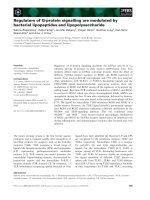
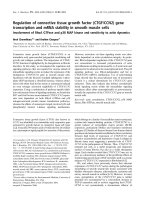

![Tài liệu Báo cáo khoa học: Expression of two [Fe]-hydrogenases in Chlamydomonas reinhardtii under anaerobic conditions doc](https://media.store123doc.com/images/document/14/br/hw/medium_hwm1392870031.jpg)
